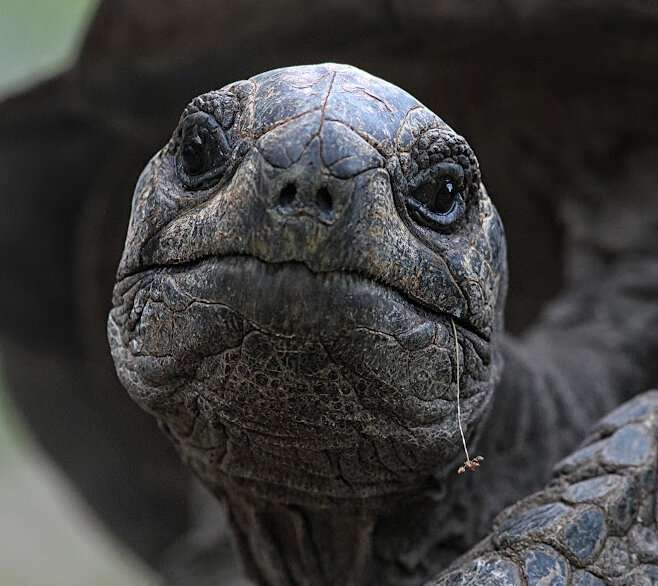Chromosome-scale genome of a gentle giant enables insights into the genetic health of a threatened population

The Aldabra giant tortoise is one of only two giant tortoise species left in the world, and it is currently on the threatened list. Conservation efforts are underway, but more and better tools to improve the chance of long-term success are greatly needed. A study published today by an international team of researchers has provided such a tool: they have completed and released an extremely high-quality genome sequence that will help to ensure a future for this vulnerable species.
Gözde Çilingir from the University of Zurich and colleagues around the world have now provided exactly that information using a range of state-of-the-art methods to achieve a "chromosome-scale" representation of the Aldabra giant tortoise genome. This work is published in the journal GigaScience.
Giant tortoises could once be found on Madagascar and a variety of western Indian Ocean islands. From fossil records, giant tortoises existed on every continent except Antarctica and Australia. Today, only two giant tortoises exist: The Aldabra giant tortoise and the Galápagos giant tortoise. The Aldabra giant tortoise (Aldabrachelys gigantea) can reach a weight of up to 300 kg, and typically live for more than 100 years, with one individual reportedly reaching 250 years of age—if so, that would make it the oldest recorded land vertebrate.
Aldabrachelys gigantea still lives in its native habitat, the Aldabra Atoll northwest of Madagascar, but the gentle giant is "vulnerable" according to the International Union for Conservation of Nature, meaning that the species is at a high risk of extinction in the wild. Having more tools and resources, especially genetic information, is one of the best ways to ensure long-term success of this amazing creature.
Lead researcher Çilingir emphasized this point, saying, "Genomic information is important for breeding efforts in zoos, to maintain the genetic diversity that is present in the wild." She also spoke about the more extensive ways these data can be of use, in particular how it can aid in comparative studies with other tortoise and turtle species, adding, "We revealed that most of the genome is similar to other known genomes of Testudines (the order comprising turtles and tortoises). Tortoise species are evolutionarily closely related to each other, and therefore our data will be tremendously helpful not only for the Aldabra tortoise but for all east African and Madagascan tortoises."
The genome sequence data the authors have generated here is at the cutting edge of what is being done in the genome sequencing arena, which is carrying out a genome sequence to "Chromosome scale." This term is used when genome sequence data is a near gap-free representation of the sequence of more than two billion genetic "letters," and the sequences are aligned in the same order as they appear in the actual chromosomes. Earlier genome sequences not only had far more gaps, but additionally the sequence data were put into what were called "scaffolds," sequences that are laid out in an order relative to one another, but that are not fully anchored in space in reference to the chromosome.
The current chromosome-scale genome sequences provide such fine-grained genomic information that it allows researchers to more accurately track genetic variation in wild and captive tortoises. To demonstrate how the new reference genome can be used for practical conservation and breeding efforts, the authors determined the sequence of thirty giant tortoises from the wild population and two individuals from the Zurich Zoo. Using this data in combination with the high-quality reference genome, they were able to determine where in the Aldabra Atollthe zoo-housed animals originally stemmed from.
Having a high-quality reference genome available for this species will thus help to answer a range of biological questions—for example, to understand why the species grows to such an enormous size. With an appetite that fits their size, giant tortoises play a major role in shaping a typical island landscape, due to the massive amount of vegetation they consume. In fact, having placed giant tortoises back in their natural environment and helping them flourish may allow them to serve as ecological replacements for the extinct giant tortoises in the Western Indian Ocean islands due to their similar central role in their ecosystems. Aldabra giant tortoises act as ecosystem engineers to restore degraded island habitats, even outside their original native area.
Restoring natural environmental protection mechanisms is an essential component for doing far more than just reducing the risk of extinction for individual species.
More information: F.G. Çilingir et al, Chromosome-level genome assembly for the Aldabra giant tortoise enables insights into the genetic health of a threatened population, GigaScience (2022). DOI: 10.1093/gigascience/giac090. www.biorxiv.org/content/10.110 … 20.488802v1.abstract
Journal information: GigaScience
Provided by GigaScience
















